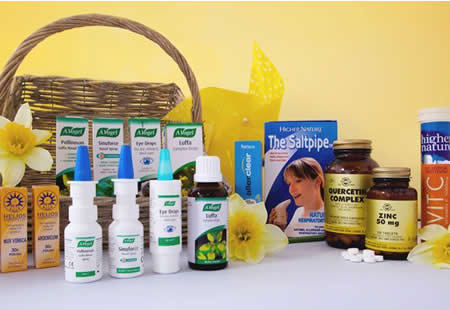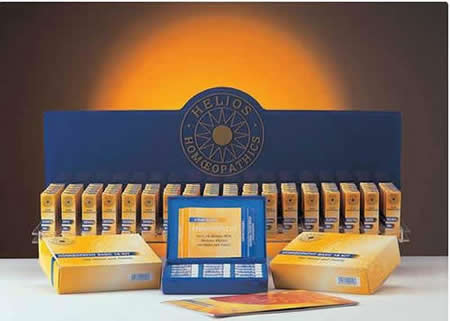Positive Health Online
Your Country

Homeopathy for Hay Fever
listed in allergies, originally published in issue 225 - October 2015
Approximately one in four of the UK population will suffer from an allergy at some point in their lives, according to the British Allergy Foundation and the number of people affected is increasing by five per cent each year. Allergic rhinitis is the cause of seasonal misery for millions of people all over the world. It most commonly takes the form of hay fever in the spring and summer, a reaction to hatching dust mites in the spring or autumn or sensitivity to airborne allergens like pet hair that can occur at any time.
Hay fever symptoms make an appearance when an allergen such as pollen triggers a hypersensitive reaction in the eyes, nose, throat and/or chest. Contact with the allergen sets off the release of histamine that causes the characteristic inflammation, streaming and congestion that are so characteristic of a nasty hay fever reaction. The potential range of symptoms can vary hugely from a mild sensation of irritation to great distress and discomfort. You are more likely to get hay fever if there is a history of asthma, eczema or hay fever in one or both parents. Hay fever usually begins in the early teens but symptoms can often improve with age.

Homeopathy is a form of complementary healthcare that works with our natural healing process and has been successfully used for over 200 years. The word comes from the Greek and means similar suffering. This refers to the central philosophy that a substance that can produce symptoms in a healthy person, can cure those symptoms in a sick person. For example a person suffering from hay fever, might be given the remedy Allium Cepa (prepared from an onion), because a healthy person chopping an onion usually experiences watering eyes and irritation. However, the substances are given in minute doses prepared in a special way to avoid unwanted side effects, making them safe to use where conventional drugs would be dangerous or inadvisable (e.g. during pregnancy or when treating children)
At Helios we receive hundreds of calls and many visitors to our pharmacy shops asking for help with allergies; by far the most common enquiry is through the spring and summer months for help with hay fever. Listed below are homeopathic remedies traditionally used for hay fever. If symptoms persist please contact a qualified homeopath or your healthcare practitioner.

Helios Hay Fever Combination 30c
A combination remedy for typical hay fever symptoms of irritated eyes and nose, sneezing etc., and contains Allium Cepa, Sabadilla and Euphrasia.
Mix Pollens and Grasses 30c
A combination made using a variety of pollens from plants, trees and various grasses which is often used in conjunction with Hay Fever Combination, on its own, or with any other indicated remedy.
Allium Cepa 30c
This remedy’s symptoms are characterized by a strong burning sensation from the nose and eyes accompanied by a watery discharge. The eyes are sensitive to light, often red and irritated, while the nose can become red and sore from the burning, corrosive mucus. There can be violent sneezing, the voice can be hoarse and there can be a hacking cough. The kind of hay fever which can benefit from Allium Cepa often comes on worse in spring or August, is worse for being in a warm room and better off for cool air. One peculiarity of this remedy is that it particularly affects the left eye or nostril, or may start off on the left side and spread to the right.
Sabadilla 30c
This is a common hay fever remedy, which is most often indicated during the early spring or at harvest time. There can be persistent sneezing, transparent mucus and an itchy, stuffed up nose. The eyes can water in the open air, from sunlight or whilst sneezing. Symptoms are also worse for cold air and there is usually improvement from eating warm food and warm drinks or from keeping warm.
Euphrasia 30c
This has a long history of use in herbalism for eye conditions so it is no surprise that the main homeopathic use is for conditions that seem to centre on the eyes. It is useful for very watery eyes, when the person may feel the need to wipe or rub them constantly. The eyelids (particularly lower) can swell up and there can be a thick, infected discharge from the eye itself. There can be the sensation of a foreign body (such as a grain of sand) in the eyes and they can become very gummed up and sore. The nasal and throat symptoms are less marked but include watery mucus, which is easily discharged. With Euphrasia the symptoms are worse for sunlight, at night-time, for windy weather and indoors, and better for the cool, open air. Euphrasia tincture can also be used as a local eyewash by diluting one drop in an eyebath of cooled sterile water. It is very soothing for sore eyes at any time - even if using a different remedy internally.
Arsenicum Album 30c
Arsenicum is indicated in people who have frequent sneezing and a blocked nose accompanied with a watery discharge. Unlike Allium Cepa the symptoms are worse outside and better for staying in the house and keeping warm. There can be inflammation of the eyes with burning and swelling which is somewhat relieved by warm bathing. The right side is generally more affected than the left and there can be a marked worsening of symptoms during the night, particularly on lying down. Generally the person requiring Arsenicum may feel unduly restless or anxious during the attack and find it difficult to get warm - even in hot weather.
Arundo 30c
Hay fever begins with burning and itching of the palate and conjunctiva. Annoying itching of the roof of the mouth and in the nostrils sometimes with pain at the root of the nose. Initially the nose can discharge clear mucus, which can then turn green and slimy with lots of sneezing.
Ferrum Phos 30c
This is a very useful remedy in the early stages of any inflammation. Taken when allergy symptoms start, it often slows or stops an episode. Symptoms include runny eyes with a burning or gritty feeling, facial flushing, watery nose and short, hard, tickling cough.
Natrum Muriaticum 30c
The most characteristic symptom of Natrum Muriaticum is that discharges have the consistency of raw egg white. The catarrh is usually white or clear and watery and can be extremely profuse. There is often repeated violent sneezing - especially in the mornings, a loss of smell or taste, and itching in the nose. The eyes can be watery and the throat can be dry and sore. Hay fever responding to this remedy can often be accompanied by violent, pulsating headaches made much worse by the heat of the sun, or by increased emotional sensitivity. The patient may prefer to be alone and feel quite touchy or tearful. In some cases cold sores can develop around the nose or lips. Symptoms are worse for heat or for lying down, and can improve for cold bathing, at the seashore, or in the open air.
Nux Vomica 30c
One of the main themes in Nux Vomica is ‘irritability’ which can be seen on the physical or emotional level. The person who needs this remedy may be cross or oversensitive, and have acute sensitivity to the slightest odour or particle of pollen. There can be a very stuffed up nose in alternating nostrils, intense itching of the ears, nose and eyes, and the unsatisfied urge to sneeze. The face can be very hot but the whole person is often rather chilly. The throat can feel rough and dry and, if the hay fever continues, the patient can experience queasiness. This is one remedy to think of, particularly if there has been a bad reaction to antihistamine drugs that have produced a disordered liver or digestion. Symptoms are worse in the morning, for stimulants such as coffee or alcohol, for strong smells, for becoming angered. There can be improvement from a short sleep, for eating or a warm drink.
Pulsatilla 30c
This remedy is normally more catarrhal with thick green catarrh produced from the eyes and nose. The catarrh can become obstructed and leads to sinusitis, nosebleeds or a loss of smell, although it is often more fluid in the open air. There is a sensation of burning and dryness in the eyes and the lids can become gummed up, with sties (or styes) forming. Generally the person who will respond to Pulsatilla can be emotionally more sensitive, irritable or tearful, with changing moods. Physical and emotional states can also be very changeable from day to day. Symptoms are normally worse in the evenings, for the sun, and better for cold applications and cool, fresh air.
Sulphur 30c
Like Pulsatilla, this remedy can have a lot of thick, offensive catarrh. There can be a general hot feeling and an aggravation of symptoms from becoming heated. The nose and eyes can become inflamed with heat and burning sensations. There can be oversensitivity to odours or changes in temperature. Classically this type of rhinitis can be accompanied by skin rash or by itching anywhere on the body. The throat can become swollen and the patient can be far more hungry than usual. Symptoms are worse for bathing, in the late morning, and better for motion or fresh air.
Wyethia 30c
Intolerable itching felt on the roof of the mouth and behind the nose, sometimes extending into the throat and ears, strongly suggest the use of this remedy. Everything in the person’s head feels dry and irritated, but the nose may still be runny.
Comments:
-
No Article Comments available